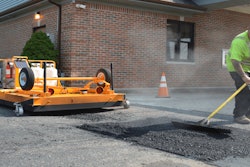
With all of our “re-start” reasons, some due to normal seasonal start-ups and some imposed on us thanks to the COVID19, it’s about that time of year when a few of the past time wastes re-introduce themselves into our crews’ work efforts. Lean Construction calls one of their seven wastes, “Waiting,” as one of the biggest costs experienced by contractors.
When I speak of “waiting,” I’m literally suggesting things that can cause our workers to wait, including:
- Equipment breakdown
- Employees late to work
- Gassing up vehicles/putting water in roller
- Late delivery of pre-arranged materials
- Job-site not accessible or prepared
- Owner didn’t unlock premises
- Emptied out current inventory of supplies
- Employee forgot important tool or equipment
- No directions available to job-site
- Crew waiting for supervisor to return from lunch
The reasons for any work delay are numerous. While the reasons can vary from day to day the costs incurred remains painfully consistent. It is easy to state that you can never replace lost time. “Down-time” in construction, for any reason, normally costs you, the contractor money and is not recoverable from the customer.
What are the costs associated with having workers waiting around? Well, let’s take a look at one situation that can provide you with a method to calculate the financial costs for waiting for work to begin or resume.
Consider a paving contractor who suddenly finds his five-man crew without asphalt to lay. There was a mix-up in the directions given to the driver and the crew is standing around for one hour before the material shows up. Let’s do a potential calculation of the costs incurred by the contractor having five workers standing around for one hour.
5 Workers X 1 Hour Waiting = 5 Total Man-Hours Spent Waiting
Average Hourly Rate = $30.00 Per Hour (Fully Burdened Rate)
5 Hours X $30.00 Per Hour = $150.00
Our cost for having labor waiting on materials is $150.00. Are there other costs? That depends on the step in the process. For example, if the crew needed this missing material to finish out a section then the hour wait might cause there to be a visible seam between the previous pad and the soon to be laid pad.
You might think that one mistake costing one-hundred and fifty dollars is no big deal. And you’re right, if this only happened once…in the year. But, we know that’s not realistic. Unfortunately, the reasons that our workers might be forced to wait can shift for one reason or another, leaving employees waiting around for five minutes here and fifteen minutes there.
Another wasteful time for workers to experience is due to lack of planning or organizing. I’ve written about this before, addressed it in many workshops, but let’s imagine that ten employees spend approximately 60 minutes a day looking for “stuff.” The “stuff” could represent things like brooms, brushes, tips, directions, cell numbers, hammers, extension cords, rake, spade, safety tape, time cards, etc., etc., etc. Now, consider that your ten employees, with an average hourly rate of $30.00. Let’s calculate the average cost for one year.
10 Employees X 60 Minutes/Day X 300 Work Days/Year = 180,000 Minutes/Year
180,000 Minutes/Year ÷ 60 Minutes/Hour = 3,000 Total Man-Hours/Year
3,000 Man-Hours/Year X $30.00/Hour = $90,000.00/Year
Therefore, by having each employee looking for “stuff” for only sixty minutes per day, we can experience $90,000.00 in fewer profits for the year. While this amount may not be terribly great for some contractors, it is still a cost that is paid due to poor organization and planning. (The sixty minutes that each field worker spends looking for “stuff” is conservative. Some estimates are closer to ninety-minutes per day. Office workers can spend up to two hours per day looking for…lost files, information on the internet, the boss, etc.)
Needless to say, we can only imagine what all of the waiting around is robbing from our organization during the course of a year. Contractors must do a better job of not only providing more clear direction and instruction but also involving their workers in learning how to determine direction for themselves.
Consider a few techniques below that you can integrate into your own approach to maximizing the amount of time spent by workers actually working.
- Develop a Weekly “Look Ahead” Schedule. This tool should identify what jobs will be performed, what resources will be needed, what day the work will be performed, and who will be completing the work.
- Conduct Daily “Huddles.” Each day should begin with a short but informational meeting. Huddles should be five to fifteen minutes. This also acts as a verbal daily planner.
- Job-Cost & Track Performance. Both efforts not only help you to improve performance but also work to keep more workers educated about what they are doing, what they will need to do it, and how they will go about doing it.
- Create Job Tools & Materials List. The document should itemize every tool and material needed to complete the intended job.
- Make Preventive Maintenance a Company Priority. Put all your equipment and vehicles on a preventive maintenance schedule and watch how much more work you experience being completed.
- “Stage” Your Job-Site at the End of Each Day. Getting the job or work site ready for the next day’s performance will save you time the following morning and warn you if you are missing anything.
So many of the techniques presented in this article are common sense, yet I still find many contractors who allow their crews to become lazy when it comes time to holding their employees accountable to be prompt, organized, and clean. Integrate the techniques shared here into your own leadership.


![Lee Boy Facility 2025 17 Use[16]](https://img.forconstructionpros.com/mindful/acbm/workspaces/default/uploads/2025/09/leeboy-facility-2025-17-use16.AbONDzEzbV.jpg?auto=format%2Ccompress&fit=crop&h=100&q=70&w=100)








![Lee Boy Facility 2025 17 Use[16]](https://img.forconstructionpros.com/mindful/acbm/workspaces/default/uploads/2025/09/leeboy-facility-2025-17-use16.AbONDzEzbV.jpg?ar=16%3A9&auto=format%2Ccompress&fit=crop&h=135&q=70&w=240)









